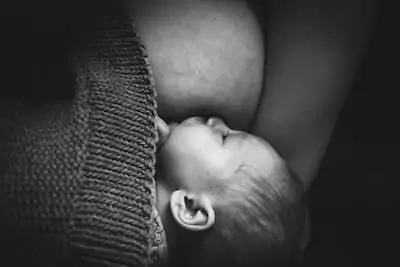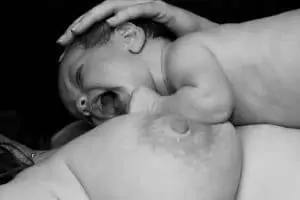When you’re breastfeeding for the first time, everything seems to be intimidating. Toss in breastfeeding with larger breasts, and you might feel as if you’re facing a daunting mountain ahead of you.
Large breasted moms can still breastfeed their babies; there is no reason for it to cause any issues with your supply or ability to do so. A lot of it comes down to learning how to properly position your baby and get yourself the support needed to succeed.
You want to be successful; I know it! So, let’s take a look at some tips to help mothers with huge breasts while breastfeeding, along with answering the questions that are on the top of your mind.
Does Breast Size Affect Breastfeeding?
The size of your breasts has nothing to do with your ability to breastfeed. Your cup size is based on the amount of fatty tissue you have inside them, which is why it can fluctuate at times. Some women experience a decrease in breast size when they lose weight.
Your fatty tissue has nothing to do with making breast milk, nor is it where breastmilk is stored. Instead, your breasts also contain glandular tissue, and that’s what produces breast milk. So, the amount of milk your breasts make isn’t related to the size of your breasts.
Do Bigger Breasts Produce More Milk?
No way! All breast sizes are capable of producing a full, healthy supply of breast milk for your babies. Your breast size has nothing to do with your ability to feed your baby.
So, big breasted women produce the same amount of milk as a woman with A cup sizes. So, for all of you women who have small boobs and wondering if bigger breasts are better for breastfeeding, don’t worry. Your boobs are more than capable of feeding your baby!
Can My Baby Suffocate Because of My Large Breasts?
This is a common worry for many large breasted mothers. You see, your baby’s face pressed against your large boobs, and your immediate thought is that he will suffocate while breastfeeding.
Don’t worry!
If your baby’s nose gets blocked for some reason while nursing, your baby will unlatch and stop breastfeeding. He will release his latch and breathe through his mouth. It’s similar to what a baby would do while nursing with a cold or a stuffy nose. They do need to take breaths properly!
If you find that you’re still worried about this, you can try using an asymmetrical latch. That means you don’t line up perfectly parallel, so it lifts your baby’s nose off your breast. Instead of your baby laying with his entire body across your body, his butt might sit on your lap with his head resting on your arm while latching.
What If I Have Flat Nipples Too?
When you have large breasts and flat nipples, you’re facing an even harder challenge, but it’s not impossible. Having flat nipples isn’t uncommon; it’s an issue a lot of women face.
Here are some tips to try when you’re breastfeeding with large breasts and flat nipples.
1. Use a Shield
You can try using a breast shell between feedings. They put pressure on the base of your nipple to encourage it to stick out more, but it needs to be removed before feeding your baby.
2. Pump Before Nursing
Using a pump or hand expressing right before nursing your baby is helpful. The suction will draw out and elongate your nipple. You don’t want to pump out a lot; the goal is to simply have your nipple come out enough for your baby to latch easily without any problems.
3. Hold Your Breast
Holding your breast in a C-shape and offering to your baby can help your baby latch easier. Doing so slightly elongates your nipple and areola, giving your baby the chance to latch.
4. Get Help!
Never be afraid to seek help! If you aren’t sure whether or not your baby is latching correctly, check with a lactation consultant or breastfeeding specialist.
12 Tips for Breastfeeding with Large Heavy Breasts
While having big boobs while breastfeeding can be a challenge, it’s not something you can’t figure out with some time and effort. Here are some of the best tips for women with large breasts while nursing.
1. Support Your Large Lactating Breasts
Mama, your girls need some serious support right now. You should get maternity bras that support your growing breasts throughout your pregnancy, and when your baby arrives, it’s even more critical to have the right fitted bras for ample support.
Even though women with large breasts often use underwire, it’s not typically recommended for breastfeeding women because the wire might apply too much pressure. That can lead to clogged ducts, discomfort, and, potentially, mastitis.
2. Figure Out the Best Breastfeeding Positions for Large Breasts

One of the keys to breastfeeding with bigger breasts is finding the position that works best for your baby. Your breasts are round, and so is your baby’s mouth, so you can find many positions that work. You must have a comfortable breastfeeding position that encourages proper latching to be successful.
So, what positions work best?
- Women love laid back feeding styles; they work well with nearly every breast shape and size. This style also encourages your baby’s natural reflexes to find the breast.
- Another option is a modified cradle hold, which is where your baby lies on your lap, and your arm support is behind his shoulders. Then, your baby attaches to your breast.
- The football hold is a classic choice for mothers with more massive breasts, but you need to make sure you don’t hunch over. It’s easy to do so in this position, and that can lead to backaches.
- Of course, another beloved favorite is side-lying nursing. It works for nearly every breast size, and it’s so comfortable. Put on one of your favorite TV shows and nurse the day away while laying in bed together.
3. Use a Breastfeeding Pillow
Another tool that can be helpful is a breastfeeding pillow. They can be used to position your baby at the right height, making it easier for you to get your baby latched onto your breast. You don’t want your baby to be too high, lifted above your nipple. Ideally, your baby will be face-to-face.
4. You Might Need to Shape Your Breasts
Shaping your breast before your baby latches on can ensure he latches onto the right spot and deeply latches. This requires holding onto your breast, but how should you hold breasts for breastfeeding?
Let me tell you!
Think of your breasts like a hamburger or a sandwich. That’s similar to how you want to grab your breast. Put your hands in a C position and cup your boobs. While doing so, you can squeeze it and reduce the size, making it easier for your baby to latch.

This technique is often called the deep latch technique, and it can be beneficial for babies with a tongue or lip tie that makes proper latching troublesome.
5. Support Your Boobs While Nursing
Now that you know how to hold your breasts properly, you’ll want to continue holding your boobs while nursing. Your breasts and gravity work against each other, and gravity can pull your nipple out of your baby’s mouth.
If you don’t want to hold your breasts the entire time, you can use a rolled towel, washcloth, or even a small blanket. Put it under your breast to help hold it up once your baby is latched.
6. Try Breastfeeding in Front of a Mirror
It can be hard to see how everything lines up from your point of view. So, sitting in front of or next to a mirror can give you a different view of your baby’s latch as well as how everything lines up. If you’re struggling to get it all to work right, mirrors can be your true friend.
7. Soften Before Latching
One major problem you might have is getting your baby to latch onto your large, engorged breasts. Engorgement overfills your boobs with milk, and it can make them feel like they’re football and just as hard. It can be challenging for babies to latch onto a rock-hard engorged breast.
If you find yourself in this position, you can try hand expressing or use a hand pump to express some milk first. That milk should be saved! Expressing softens your breasts and makes it easier for your baby to latch.
8. Watch Out for Itchiness and Rashes
You probably already know that having larger breasts increases the risk of yeast and bacterial infections growing underneath. You also need to contend with heat rashes in the folds. When you’re breastfeeding, yeast infections’ risk increases because milk can easily leak down and become trapped under your breasts.
To help, make sure you wear cotton bras and change them often, especially when you’re sweaty. Wash your breasts with water and dry thoroughly before putting on a bra. Some moms find using a hairdryer on low is helpful.
9. Don’t Be Afraid to Ask for Help
If you’re struggling, asking for help isn’t a sign that you failed. Lactation consultants WANT to help breastfeeding mothers be successful and meet their personal goals. Most hospitals offer LCs on staff to help new mothers, but that doesn’t mean you can’t seek help after leaving the hospital.
There are thousands of LCs, so there is a good chance you can find someone local to you. Ask your pediatrician or OBGYN for recommendations, or place a call to your local WIC office.
Talking to a lactation consultant can help you find the best comfortable positions and show you how to build up your milk supply. They can also help you find the best-sized flange for your pump if you plan to use one.
Relative: How to increase milk supply by eating lactogenic foods.
10. Practice Breastfeeding in Public
The first few weeks after you have your baby, you might not feel comfortable and confident enough to breastfeed in public, but the time will come eventually when you need to do so. Practice makes perfect!
When you’re out, make sure you wear easily accessible clothing that makes nursing your baby possible without fighting all of your clothes. Keep a thick blanket on hand with you. Since you can’t carry your breastfeeding pillow around with you, a folded thick blanket can be the next best thing. Roll or fold it and put it under your arm to offer support.
11. Try a Nipple Shield
If you find that you struggle to get your baby to latch correctly, you might want to use a nipple shield to protect your raw, cracked, and uncomfortable nipples until you can get help from an LC.
A nipple shield is a great tool. It’s a thin piece of silicone that you put over your nipples to help your baby latch and feed. It also protects your nipple from becoming damaged or more damaged in the process, but they aren’t meant to be used forever.
12. Get The Right Sizes for Your Areolas
If you’re using breast shields or pumping, you need to make sure you buy the right size. Flanges, for breast pumps, aren’t one-size-fits-all, although that would make life considerably more comfortable. Buying sizes too small or too big can make pumping hard.
Shields and flanges are meant to fit over your areolas; that’s how they determine size. It has nothing to do with the cup size of your bra. If you get the wrong size, not only will it be uncomfortable, but you won’t express as much milk.
Final Thoughts
Breastfeeding can be hard enough without adding complications, and learning how to breastfeed with larger breasts can throw you for a loop. It can come with extra challenges, but it doesn’t mean you won’t be successful. With the right preparation and supplies, you’ll breastfeed like a pro in no time!
Hey, this is Linda. My biggest accomplishment in life is being a mother of four children. Their current ages range from almost ten years old down to 20 months old.
I’m passionate about writing parenting articles because I understand so well all of the problems and trials you face as a parent. From breastfeeding woes to budgeting problems and behavior problems, along with everything in between, chances are I’ve faced it over the last ten years. Read more about Linda here.







